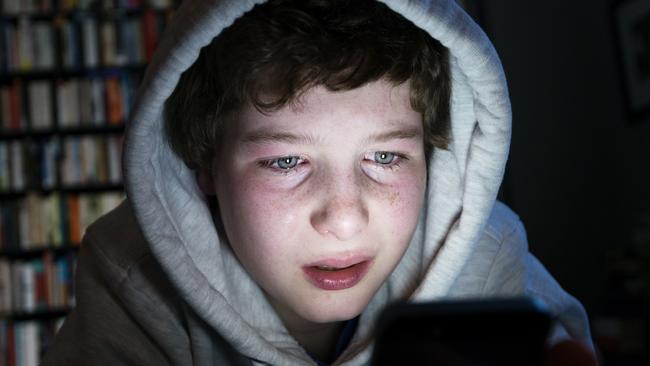Evil sex scammers using artificial intelligence to target Victorian children
A horrifying number of Victorian children are falling prey to sextortion predators daily, and police warn artificial intelligence is now being used to create fake images to coerce even more victims.
Police & Courts
Don't miss out on the headlines from Police & Courts. Followed categories will be added to My News.
Thousands of Victorian children are being preyed on every day by international scammers seeking sexual images so they can blackmail them.
A specialist police squad says the extorters are now even using artificial intelligence to doctor innocent photos, with victims’ faces put on pornographic images.
This means children who have not even sent sexualised pictures are being coerced into handing over cash amid threats the fake images will otherwise be leaked online and sent to family and friends.
The Joint Anti Child Exploitation Team (JACET) – involving Victoria Police and Australian Federal Police – is warning that more children are expected to be targeted in the “sextortion” racket over the summer holidays.
“The offenders are not working harder during the holiday breaks, the kids are just more accessible and they don’t have school to occupy their time,” Leading Senior Constable Ben Rutherford said.

It was common for each offender to be seeking to extort money out of hundreds, if not thousands, of victims at any one time, officers said.
In the vast majority of cases there was no sexual gratification involved.
“Since Covid forced more and more people online we’ve seen a real spike in offending,” Detective Acting Senior Sergeant Warren Hutchison said.
Police said sextortion victims were overwhelmingly teenage boys, mainly targeted by offshore offenders, who made demands for money or gift cards worth $10 to thousands of dollars.
Children are befriended by users online who pretend to be the opposite gender and of a similar age.

“A young boy will be friended by someone who he believes to be a young female, there will be an exchange of explicit images between the parties and then any images that are sent by the child victim are then used to blackmail them into providing money or purchasing gift cards,” senior intelligence analyst Lauren-Ann Szostak said.
“We’ve seen instances where a 13-year-old victim says they can’t pay the financial demand and the scammer has asked how much money they do have and then taken their $10 of pocket money. It’s awful.”
Sergeant Hutchinson said: “Boys, at this age, are predominantly interested sexually – they’re very engaged and interested in pursuing a sexual kind of element. And if they have who they perceive as a female showing an interest in them, it breaks down this barrier and just makes them so vulnerable, so quickly.

“Offenders are efficient and proficient and have a very clear spiel and methodology around what they’re trying to achieve.
“They know that if they put some conversation towards these boys that makes them feel good about themselves and they’re very quickly going, ‘Oh, yeah, I’ll send you a picture of me, because what am I going to get in return’.
“And it quickly turns from who they think is an interested female, to someone that they have no idea who it could be. At first they think it’s someone playing a prank on them until threats of the images being distributed to their friends and social networks start.”
The scammers, largely based in Nigeria or southeast Asia, will either send a nude photo purporting to be them or coerce a picture from the victim. Then the threats start.
“Once the images are exchanged the offenders will then usually send them back the images, send them screenshots of their friends list or screenshots of their school or sporting club or workplace and make comments like, ‘Oh this looks like your mum, should I send the pictures to her?’” Ms Szostak said.
“The threats are tailored towards the victims who are embarrassed, ashamed and frightened, and it’s obviously very, very distressing for them.
“And then they’ll make demands. So whether it’s payments through a certain account or requests for the child to buy gift cards online and then email them to the offender,” she said.
“It’s so widespread and high volume but if you can get $100 from each target and you’ve got 1000 victims, that’s why they don’t stop,” Sergeant Hutchison said. “The threats come thick and fast and usually have an urgency about them, giving deadlines. We’ve seen instances where victims have been at the police station and they are still getting the messages. It’s unrelenting.”
Despite the huge rise in reporting, police say it is only the tip of the iceberg.
“We probably don’t fully understand the full volume. And, I would suggest, for someone to come to the police station and report it, they’re not probably coming in after sending one image,” Sergeant Hutchison said.
“It’s probably got to a point where they’re backed into a corner and feel like they’ve got nowhere else to go.”
Ms Szostak added: “It’s really important for victims to know that they’re not alone, that this is happening to a lot of people. Hopefully that will encourage people to report it.



